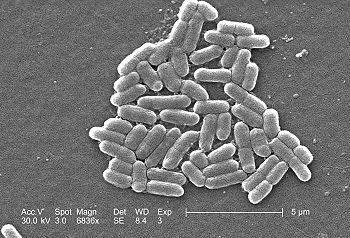Escherichia coli: Difference between revisions
Jump to navigation
Jump to search

imported>Subpagination Bot m (Add {{subpages}} and remove any categories (details)) |
imported>Richard Pettitt (added image) |
||
| Line 1: | Line 1: | ||
{{subpages}} | {{subpages}} | ||
[[Image:E. coli O157-H7.jpg|right|thumb|350px|{{#ifexist:Template:E. coli O157-H7.jpg/credit|{{E. coli O157-H7.jpg/credit}}<br/>|}}A magnification of the E. coli strain O157-H7, capable of producing a powerful toxin which can cause severe illness. Most infections come from eating undercooked ground beef.<br>Credit: Janice Carr]] | |||
'''''Escherichia coli''''' (commonly known as ''E. coli''), is one of the main species of [[bacteria]] living in the lower intestines of mammals, known as gut flora. When located in the large instestine, it assists with waste processing, vitamin K production, and food absorption. Discovered in 1885 by Theodor Escherich, a German pediatrician and bacteriologist, ''E. coli'' are abundant: the number of individual ''E. coli'' bacteria in the feces that a human defecates in one day averages between 100 billion and 10 trillion. However, the bacteria are not confined to this environment, and specimens have also been located, for example, on the edge of hot springs. | '''''Escherichia coli''''' (commonly known as ''E. coli''), is one of the main species of [[bacteria]] living in the lower intestines of mammals, known as gut flora. When located in the large instestine, it assists with waste processing, vitamin K production, and food absorption. Discovered in 1885 by Theodor Escherich, a German pediatrician and bacteriologist, ''E. coli'' are abundant: the number of individual ''E. coli'' bacteria in the feces that a human defecates in one day averages between 100 billion and 10 trillion. However, the bacteria are not confined to this environment, and specimens have also been located, for example, on the edge of hot springs. | ||
Revision as of 13:01, 27 December 2007
Escherichia coli (commonly known as E. coli), is one of the main species of bacteria living in the lower intestines of mammals, known as gut flora. When located in the large instestine, it assists with waste processing, vitamin K production, and food absorption. Discovered in 1885 by Theodor Escherich, a German pediatrician and bacteriologist, E. coli are abundant: the number of individual E. coli bacteria in the feces that a human defecates in one day averages between 100 billion and 10 trillion. However, the bacteria are not confined to this environment, and specimens have also been located, for example, on the edge of hot springs.
